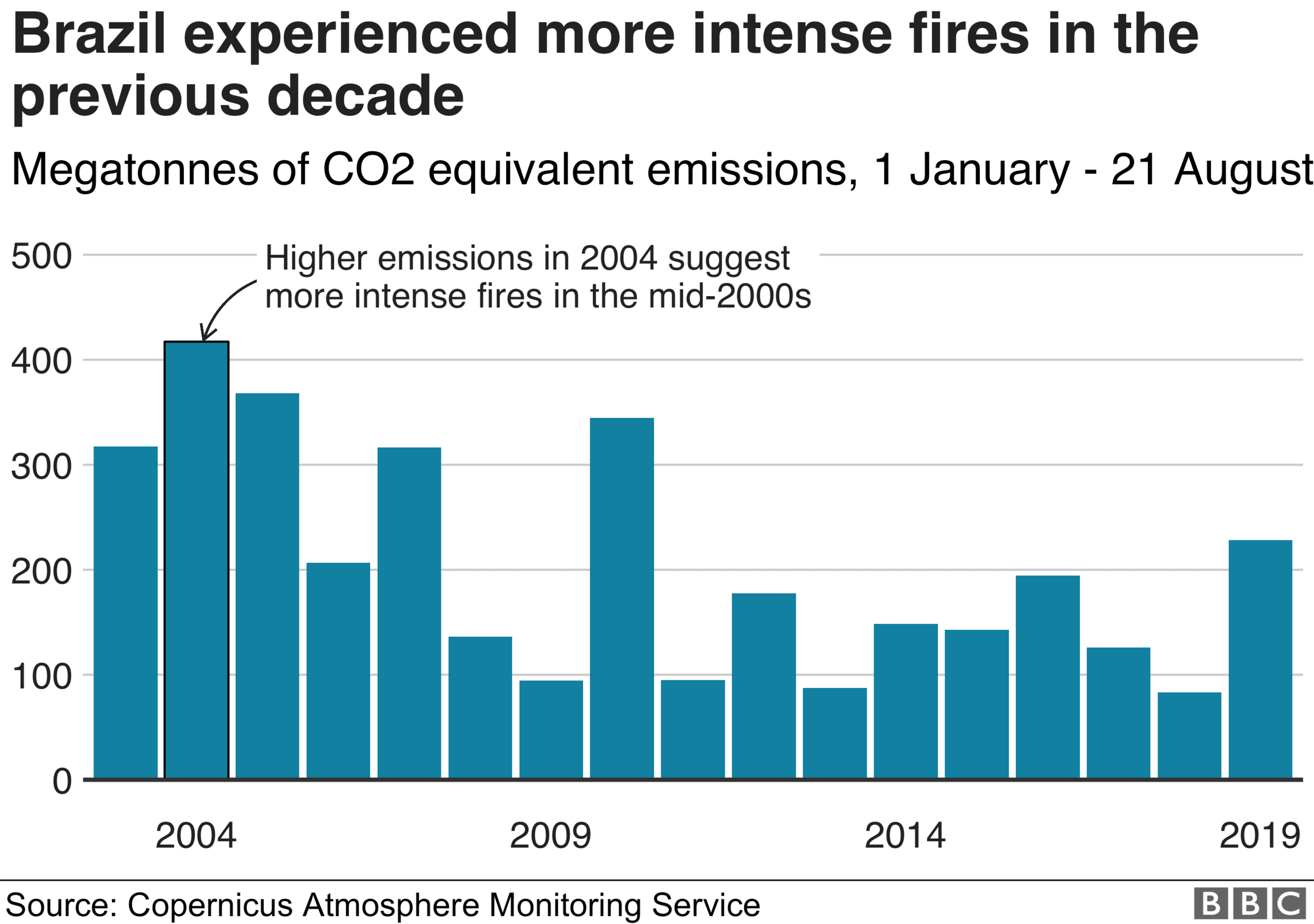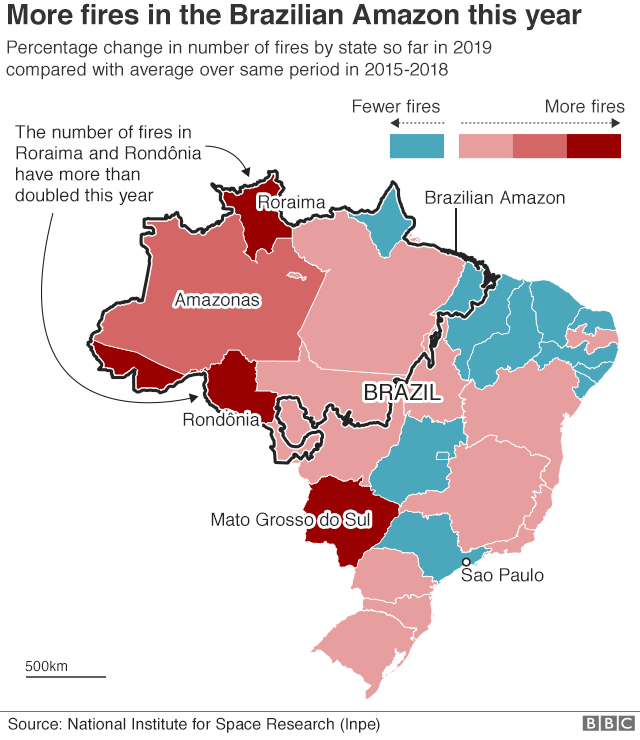Amazon fires: Forest loss challenges Paris climate ambition
- Published

The fire in Mato Grosso is one of the worst ones in the Brazilian Amazon basin
The kind of flaring fires seen in the Amazon forest this year would make the Paris climate target more difficult to achieve, scientists have warned.
The treaty aims to limit global temperature rise to well below 2C above pre-industrial times to avoid dangerous impacts.
Tree cover loss from tropical forests is estimated to account for nearly 10% of global carbon emissions.
While trees are also said to provide more than 20% of climate solutions.
They not only absorb carbon dioxide from the atmosphere, they then lock that carbon away.
The world is currently on track for a temperature rise this century of 3C or more, posing a significant challenge to the Paris ambition, according to the World Meteorological Organization.
A study last year by Global Forest Watch showed if tropical tree cover loss continued at the rate it was then it would be nearly impossible to keep warming below the pledged 2C.
"The fires in the Brazilian Amazon this year certainly pose a challenge for the climate target we have set for ourselves," said Doug Boucher, Tropical Forests & Climate Initiative scientific advisor with Union of Concerned Scientists.
"The concern is also because Brazil's basic policy of forestry has been turned on its head by the new administration and it might undo the significant progress the country saw in recent years."

The US space agency (Nasa) satellites have confirmed an uptick in fires in the Brazilian Amazon, making 2019 the most active fire year in that region since 2010.
Brazil's space agency calculates an 85% rise in fires this year.
Nasa, Brazilian agency on same page
Initially, the two space agencies appeared to have their own respective takes on the situation, but now they seem very much to be speaking with one voice on the topic.
"INPE (the Brazilian agency) also uses active fire data from Nasa's Modis (satellite) sensors to monitor fire activity in the Brazilian Amazon," said Douglas Morton, chief of the Biospheric Sciences Laboratory at Nasa's Goddard Space Flight Center.
"As a result, Nasa and INPE have the same estimates of changes in recent fire activity."
Modis detections are higher in 2019 than at this time last year in all seven states that comprise the Brazilian Amazon.
Felled trees the 'real problem'
The Brazilian government has sent in the army to fight the fires while it has rejected international aid assistance for the job.
But the fire season has just begun and there are fears that the situation could get worse.
"Even if the fires are contained now, the real worry is the cut down forests in the region," said Mr Boucher.
He explained that as soon as trees are felled, they begin to release the carbon dioxide stored in them, whether or not they are set alight.
Experts say trees are first felled to clear the forests for agriculture, cattle-ranching or mining in the tropical region.

Fires are then set to create the space and to pass the nutrients from burnt vegetation into the soil.
Annual gross carbon dioxide emissions from tree cover loss in tropical countries averaged 4.8 gigatonnes per year between 2015 and 2017, according to Global Forest Watch.
"If tropical deforestation were a country, it would rank third in carbon dioxide-equivalent emissions, only behind China and the US."
The Amazon is the world's biggest rainforest and the Brazilian share of the forest is nearly two-thirds.
The fires in the Brazilian Amazon basin this year had emitted 228 megatonnes of CO2-equivalent by last week, according to the EU's Copernicus Atmosphere Monitoring Service.
Fire frontiers
"The question is how far the frontiers of fire will move and how much of the remaining forests will be degraded by the smoke of these fires," said Rod Taylor, global director of the forest programme at the World Resources Institute.
"And are they going to break the record of deforestation of the early 2000s?
"This is all very worrying in regards to the global climate target."
Across the Brazilian border, rainforest in Bolivia is also burning.
The size of the fires is estimated to have doubled since Thursday. About one million hectares - or more than 3,800 square miles - is affected.
The Intergovernmental Panel on Climate Change (IPCC) recently brought out a report highlighting the damage being done to the land surface of the planet.
It said human activities were degrading soils, expanding deserts, felling forests, driving out wildlife, and draining peatlands.
In the process, the IPCC added, land was been turned from an asset that combats climate change into a major source of carbon.
But scientists also say that deforestation presents just a share of the climate problem, and a relatively small one at that.
"The fundamental issue in fighting climate change is fossil fuels," said Guido van der Werf, a climate scientist with Vrije Universiteit of Amsterdam.
"It might be too early to draw conclusions about how much of climate damage these fires in the Amazon have done.
"And even if we find that out, it will be a few percent of global fossil fuel emissions at most. But, obviously, the Amazon also has many other functions that will suffer from deforestation."
There have been big forest fires in other parts of the world including in Indonesia, Siberia and Europe in recent days.